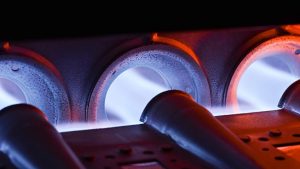Endothermic process and heat treatments are essential for ensuring high-quality metal and alloy products.
Endothermic gas (CO/H₂/N₂) is often used as a ‘neutral’ protective gas or carrier gas during heat treatment process. Monitoring and controlling the furnace gas composition is essential to ensure metallic products retain their desired properties. This article outlines why CO and CO₂ levels must be precisely controlled, and the best way to measure CO and CO₂ concentrations in endothermic heat treatment furnaces.
Heat treatments are commonly used to alter the physical or chemical properties of materials such as metals and alloys, including steel. Heat treatments result in changes in material microstructures that provide increased hardness, temperature resistance, ductility, and strength.
Although the name ‘heat treatment’ suggests a simple procedure, process parameters including time, temperature, and atmosphere during heat treatments must be carefully controlled to obtain the desired material characteristics and ensure high-quality products.1-3
Furnace Atmospheres Provide Protection and Controlled Material Modification
Gases are often introduced to furnaces during heat treatments to provide a protective environment, controlled oxidation, or to act as a carrier for substances intended to modify the material or surface.
One of the most common atmospheres used during heat treatments are endothermic gas compositions, which are typically used as a ‘neutral’ hardening gas, or a carrier for gas carburizing or carbonitriding.
Endothermic gas mixtures are typically produced by endogas generators, which heat natural gas and air in the presence of a catalyst to produce endothermic gas. The reaction consumes heat- hence the term ‘endothermic has’.4-6
Endothermic Process of Gas Composition must be Carefully Controlled to Ensure Product Quality
The main objective of a protective furnace atmosphere is to prevent undesired decarburization, hydrogen embrittlement, oxidation, surface bluing, and soot formation.
For the desired metal treatment to be successful, the gas composition must be carefully monitored and strictly controlled. Measuring the concentrations of CO, CO₂, H₂, H₂O, N₂ and CH₄ in the generated endothermic gas atmosphere can help ensure that both the endogas generator and the furnace are operating correctly and prevent any undesired reactions.4,5
The presence of O₂ or excess CO₂ in endothermic gas can result in oxidation reactions, such as iron oxidation.
Fe + CO2 ⇌ FeO + CO
Iron oxide can form a visible layer on the surface, known as scale. To maintain the brightness of steel, oxidation of iron should be limited, be eliminating oxygen from the furnace and limiting the presence of CO₂.4,7
The properties of steels strongly depend on their carbon content, so it is important to prevent undesired decarburization during heat treatment. Decarburization causes carbon to diffuse towards the surface of the steel, reducing overall strength and fatigue resistance.
Fe3C + CO2 ⇌ 3Fe + 2CO
Oxidizing gases like O₂ and CO₂ induce decarbonization, while maintaining the presence of reducing gases such as an excess of CO and H₂ can help prevent undesired decarburization by pushing the equilibrium in the direction of the carburized product.4,7,8
Measuring the Endothermic Process of Gas Composition in Furnaces
Endothermic furnaces are commonly monitored using dew point analyzers or oxygen sensors. However, this method of monitoring a furnace assumes that the endothermic gas mixture has a consistent composition, which may not always be the case.
Ideally, furnaces should be equipped with a combination of measurement solutions, including dew point analyzers O₂ probes, and CO/CO₂ analyzers, enabling all the important parameters to be monitored and controlled.
The latest endothermic generators measure the furnace gas composition and automate the delivery of methane and air to the endogas generator to provide consistent endothermic gas delivery to the furnace.7
Using CO and CO₂ analyzers to monitor the furnace atmosphere provides precise information about the endothermic gas composition delivered to the furnace. infrared sensors offer the ideal solution for measuring CO and CO₂ in endothermic furnaces, as they are simple to use, provide rapid measurements, and easy to interpret results. What’s more, infrared sensors can be easily incorporated into systems intended to alter endothermic gas production and delivery automatically.7
Infrared Gas Sensors for Endothermic Processing
Edinburgh Sensors are a leading supplier of high-quality gas sensing solutions, including a comprehensive range of infrared sensors for reliable CO and CO₂ measurement.11
Edinburgh Sensors offer nondispersive infrared sensors (NDIR) sensors as complete gas monitors (Guardian NG Series) and OEM infrared sensors designed for integration into a wide range of systems (Gascard NG).
While some IR sensors suffer from the effects of temperature or pressure, those from Edinburgh sensors offer extensive temperature and pressure correction to ensure accurate results in a wide variety of environments.12,13
References and Further Reading
- ‘Practical Heat Treating: Second Edition’ – Dossett JL, Boyer HE, ASM International, 2006.
- ‘Heat Treatment: Master Control Manual’ – Bryson WE, Hanser Fachbuchverlag, 2015.
- ‘Heat Treatment of Steels – The Processes’ – https://www.azom.com/article.aspx?ArticleID=543
- ‘Considerations in Heat Treatment. Part One: Furnace Atmospheres’ – Herring DH, industrialheating.com, 2009.
- ‘Principles and Use of Endothermic Gas Generators’ – http://heat-treat-doctor.com/documents/Endothermic%20Gas%20Generators.pdf
- ‘An Overview of Endothermic Generators’ – http://www.mcgoff-bethune.com/furnace/endo.pdf
- ‘Thermal Process Information Book’ – ASM International, Heat Treating Progress, 2008.
- ‘Decarburization – Metallurgical Processes’ – https://www.azom.com/article.aspx?ArticleID=9624
- ‘Non-Dispersive Infrared Gas Measurement’ – Wong JY, Anderson RL, IFSA Publishing, 2012.
- ‘Handbook of Gas Sensor Materials: Properties, Advantages and Shortcomings for Applications Volume 1: Conventional Approaches’ – Korotcenkov G, Springer, 2013.
- ‘Edinburgh Sensors’ – https://edinburghsensors.com/about/about-us/
- ‘OEM Gas Sensors’ – https://edinburghsensors.com/products/oem/#products
- ‘Gas Monitors’ – https://edinburghsensors.com/products/gas-monitors/
Keep in Touch
If you have enjoyed reading this article on Endothermic Process, and would like to see more from Edinburgh Sensors, then sign-up to our infrequent newsletter via the sign-up button below, and follow us on social media.

